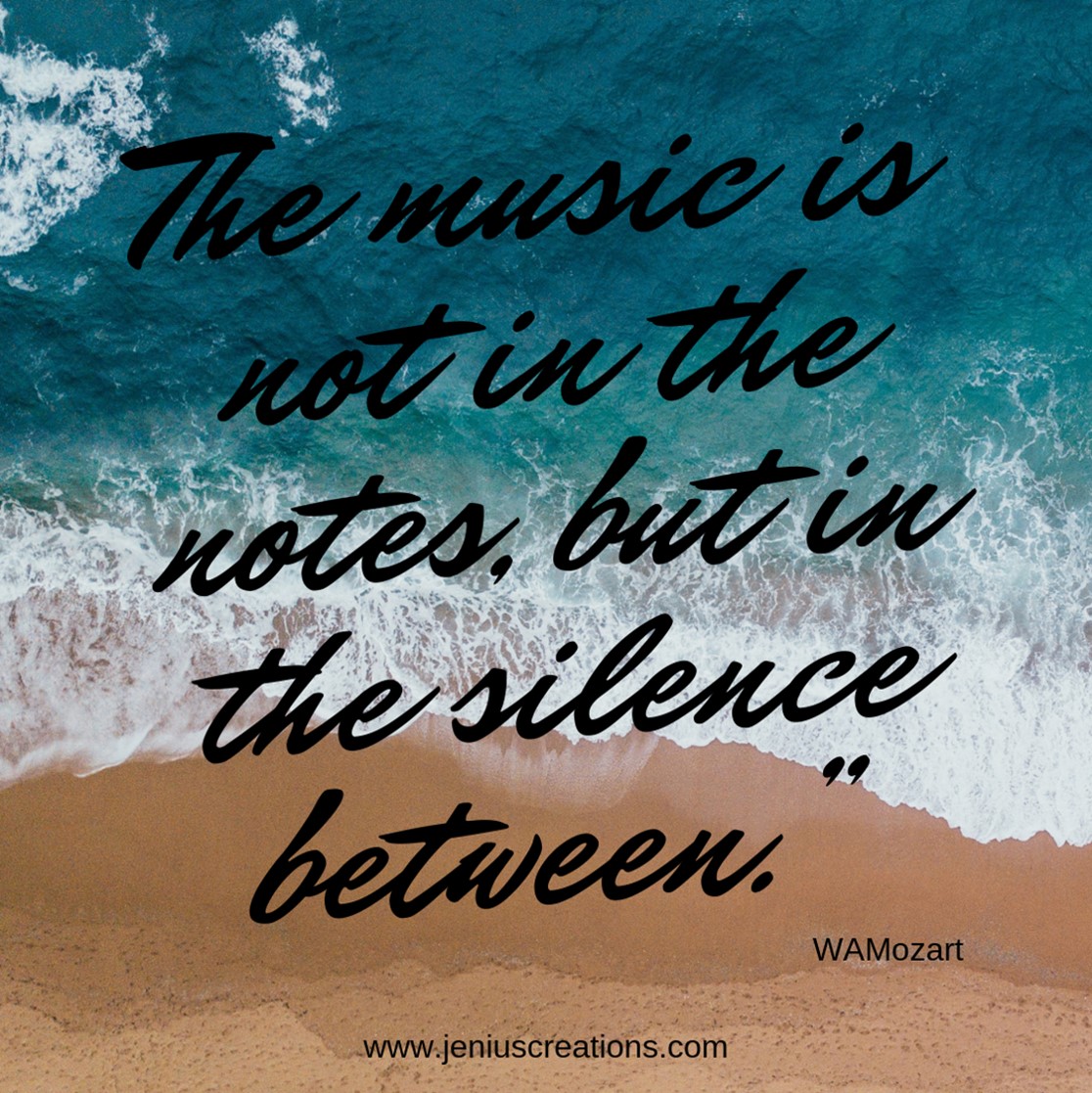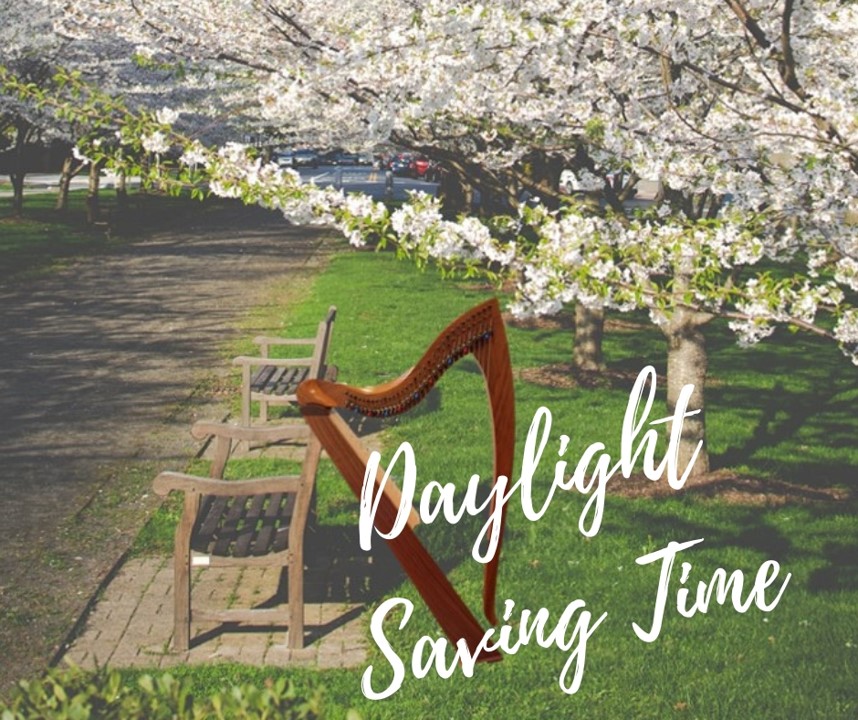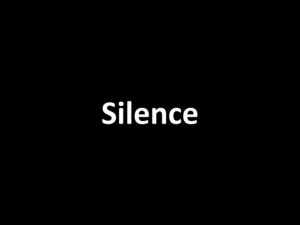Blog
-
Stay between the lines!
I was driving down the highway the other day. I was going about 1000 miles, so on one particularly long, straight stretch, I started remembering when I learned to drive.
For me, one of the hardest things to learn was staying in the middle of the lane. When you start to drive, you know you need to stay in the lane – and between the lines. The lane is defined by the lines, so I looked at the lines – constantly. But you know how that goes – the more you look at the lines, the farther you are from your desired position – in the middle of the lane. The best advice (or training) I got was to look down the road – look way down the road. After I (finally) learned that, staying in the lane was so easy. Now, as an experienced driver, I don’t even see the lines close to me and keeping the vehicle in the middle of the lane is something I take for granted. It seems that I just go where I meant to be.
The reality is, no matter how good a driver you are, you will never stay in your lane to get where you’re going if you don’t look ahead. So, what does that have to do with playing the harp? Everything!
 When you’re learning a new tune – what do you do? I don’t know about you, but when I’m having trouble getting a tune into my head, I naturally narrow my thinking down to just what comes next – what’s the next note. But this doesn’t actually help me learn the tune. It just frustrates me (thus drawing my focus away from what I’m trying to do – learn the tune). If I lift my head and keep my focus “down the road”, then I can think of the phrases (as phrases, not as a trickle of sounds). When I can hear the tune in my head, the notes that come next become so much easier to remember.
When you’re learning a new tune – what do you do? I don’t know about you, but when I’m having trouble getting a tune into my head, I naturally narrow my thinking down to just what comes next – what’s the next note. But this doesn’t actually help me learn the tune. It just frustrates me (thus drawing my focus away from what I’m trying to do – learn the tune). If I lift my head and keep my focus “down the road”, then I can think of the phrases (as phrases, not as a trickle of sounds). When I can hear the tune in my head, the notes that come next become so much easier to remember.When you’re reading music, the notation (the lines and everything else) are helpful – but can be distracting. Again, sometimes just having all that ink only serves to draw your attention to the individual blops – and you lose track of where you are on the page, in the phrase, in the music. When you lose your place, your hands may not end up in the right place, or they might be going the wrong direction or be overstretched! Keeping the long view will allow you to read the music rather than focusing on the ink and better allow you to be more able to play.
When you’re playing, you have learned the tune or become familiar with the dots on the sheet. When you’re playing, you want to be “in the moment” – and that is important. But remember that music isn’t static or fixed. Music is serial, it comes out over time – like the road! It can’t come out all at once (although there are some composers who clearly do not agree with me on that!). So being in the moment has to include the plans for this moment, and then for the next moment, and then the following moment, and on and on until the end of the piece – as a flow. This is not contradictory, rather, you need to hold the music in your head as a piece rather than as a set of notes. Looking at the whole of the music, rather than on just it’s representation (that you learned or are reading), will help keep you on track.
When you’re performing, you really are taking all that you have learned and putting it out there in the world to share. This is more than just playing in that now. Because now, in addition to being in the moment with the music, you must also be present with the listeners. Whether there are 2 or 200 or 2000 in the audience, your focus has to be “farther down the road” to include not only the music but also the hearers and what your message to them/with them is. Here, your long view includes them, the music, and the presentation. Keeping an eye on where you want to take them with the music, what it is you want to share, and how you mean to do that will help give you a smooth ride.
Of course, this is a simple analogy. There are many things on the road that require attention (like stop signs, traffic, pedestrians, etc.). And just like that, music (written or aural, practice or performance) has details (like dynamics, tempo, timbre, etc.) which enrich the ride and improve the experience. But, just as staying between the lines becomes second nature, learning, reading, playing and performing can also become second nature so that your music grows, flourishes, and delights. And just like any journey, when staying between the lines comes naturally and effortlessly, you can enjoy the journey so much more easily. What are the lines you have a hard time not looking at? How do you stay in the lane? When you look down the road – what do you see? Leave me a comment and share how you do it!
-
Permission Granted x20
Playing the harp is more challenging than it looks. You already know that. That’s why we work hard during practices. It’s why we try to practice regularly – so that we enjoy small, incremental improvements each day. And this is one reason I’m always suggesting that we track our progress – to acknowledge, accept, and grow from that practice.
Practicing certainly gives us a way to work on the technical aspects of playing, but there is so much more to playing – things that go beyond the technical. However, to get to those things we sometimes need to get out of our own way.
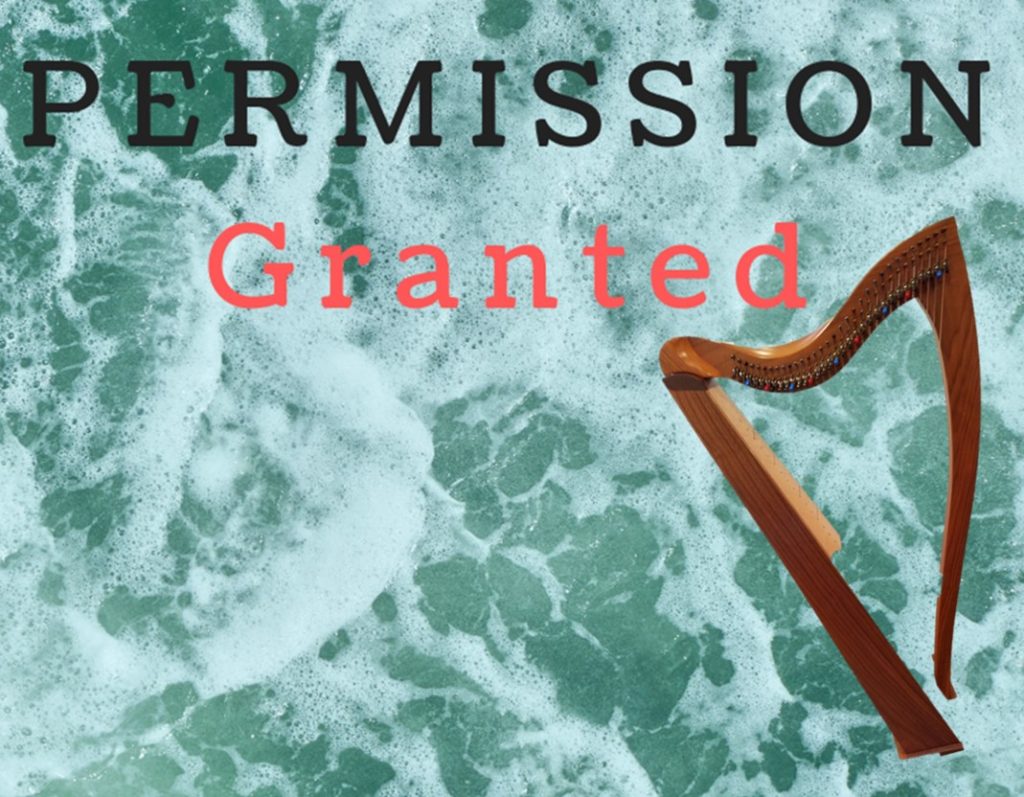 So, how do we do that? We start by giving ourselves permission. Permission for lots of things. But mostly, you have to give yourself permission to be YOU!
So, how do we do that? We start by giving ourselves permission. Permission for lots of things. But mostly, you have to give yourself permission to be YOU!Here are 20 types of permission you might consider giving yourself:
- Permission to fail. It happens. Actually, if you’re learning, you’ll fail a lot on the way. But if you refuse yourself the opportunity to fail, you won’t learn…and that would be a shame.
- Permission to be silly. There is so much seriousness in music, but a little silly will probably help you enjoy more.
- Permission to give it rest. Sometimes you need to percolate – and taking a little break will give you the option to do just that.
- Permission to be as good as you are (and no better). You are where you are. Be there.
- Permission to work on just one thing (until you get it right). Sometimes we think we have to master everything, all at once. But this doesn’t really do much except frustrate you.
- Permission to do scary things. When you scare yourself, you learnt that it didn’t kill you to try something new. We’re usually most scared that we will embarrass ourselves – you’re going to embarrass yourself one way or another, so embarrass yourself your own way!
- Permission to get out there and share. We often huddle in the safe cocoon of our harp room at home. But the music is best shared – so get out there!
- Permission to fail again (and again and again and again). You can’t just stop at one failure – do it over and over and over – and each time you’ll learn more that you can apply to the next failure.
- Permission to make art in multiple ways. This can be as small as playing a new kind of music or as big as learning to sculpt or paint or write. All your art will work to help you in the others.
- Permission to create “first drafts” (and second and third and on and on as needed). You know that what you see on stage or on YouTube is not spontaneous, right? So why do you expect your initial efforts to be performance ready? Think of the pre-work as your “drafts” that you will continue to refine and develop – until they are ready to share.
- Permission to have fun. Ok, this is pretty self-explanatory!
- Permission to laugh at yourself. No really, you should be able to laugh at yourself. Keep it light – it’s not rocket surgery after all.
- Permission to expect more from yourself. You don’t have to be content with your lot – you can want more (as long as you’re willing to work for it).
- Permission to be good at some things, not good at some others, and even to be terrible at a few. Here’s an example – I’m good at playing the harp, I’m not as good at cooking and I’m terrible at gardening. I’m ok with that – I allocate my time and resources accordingly (e.g., I practice for hours, I heat soup for dinner, and I pay a kid in the neighborhood to tend the garden – that’s that sorted!).
- Permission to practice as much as you need – and no more. I know some of you struggle to get your butt on the bench, but others spend too much time there – practice while it’s productive, and then go do something else. Got a deadline? Try a little practice multiple times in the day.
- Permission to be happy with where you are. This might seem counterintuitive (or counter to development) but it’s not – you are where you are. Be there. Right then. Realize too that time is a river – there is only constant change and you are changing when you are where you are – give yourself permission to accept that.
- Permission to want more. You think I’m contradicting myself – but remember I said there is constant change – if you want more, want it – and work for it!
- Permission to change your mind. Playing classical music and tired of it? Trapped in session tunes but longing for something more “substantial”? OK. It’s ok to change your mind about what you want to play. Just do it.
- Permission to keep track of what you are doing…and what you want to do next. However, you need to – keep track in your own way and build on that.
- Permission to spend your valuable time doing what you love. After all, time may be your most precious commodity – so spend the time you have doing what you love.
There are plenty of permissions to give yourself. What other ones do you give yourself (or do you need to give yourself)? Share that in the comments!
-
Is it getting warm in here?
Yes, it’s now spring. And yes, temperatures are going up – it’s starting to get warm. The question is – are you?
Every morning, when I head out for a walk or run, I start slow. Work out the kinks. Settle into my body. Paying attention to my body. Feeling my feet hit the ground and roll up again.
Do you take the time to warm up when you play? No matter if you’re practicing for 15 minutes or preparing for a 3 hour background gig, you should should take a little time to warm up. Why?
Really?
 Oh yes – you need to warm up! One of my favorite sayings is that musicians are the athletes of the small muscles. This is central, not only because it equates us with athletes – who are more far more respected in modern society – but also because it focuses on the corporal elements of making music, rather than on how “pretty” our music is!
Oh yes – you need to warm up! One of my favorite sayings is that musicians are the athletes of the small muscles. This is central, not only because it equates us with athletes – who are more far more respected in modern society – but also because it focuses on the corporal elements of making music, rather than on how “pretty” our music is!While we may not spend hours in the gym (not that getting additional exercise would be bad), you can still keep in mind that you’re about to do physical work. Caring for those muscles will allow you to do more.
Why is warming up so important? Well, for at least four reasons:
- Gently moving lets those muscles gradually make ready to work. While significantly experienced humans (read: older) probably appreciate this, it is important begin to warm up long before you even actually feel the need to do it. And if you are a growing human (read: not yet out of adolescence) you have the opportunity to build the habit long before you need it.
- Warming up is work – it’s “pre-work” so it is a legitimate part of your practicing time.
- Warming up is actually about warming up – you want to warm up those hands that they will be more limber and flexible.
- Warming up is a great time to check in on yourself – to really focus on how you feel and if you are ready to play.
But, you don’t just warmup for the fun of warming up! Doing some warmups will allow you achieve flexibility to play better. Warmer hands will result in better technique because your hands will be better able to move – keeping your thumbs up maybe? will be easier if your hands are limbered up. Loads of crossovers for scales? certainly easier if your whole hand is warmed up and working together. And of course, it’s not just your hands – you should warm up your arms and shoulders at a minimum.
What should you do to warmup? Here are a couple of ideas:
- Wash your hands in warm water with nice soap – be luxuriant. Massage your hands while you’re at it.
- Simple stretching. Stretch. Go slowly. Raise your arms overhead and reach for the ceiling. Stretch through your fingers. Wiggle your fingers. It’s not a race and it should be like when you wake up. Don’t overstretch.
- Palm taps – you probably learned this in your first lesson. Tap your palm with each of your fingers to mimic closing.
- Shoulder rolls – this is an iconic stretch – do rolls both forward and back.
Then move to your harp and begin there – you already know this but remember – you’re warming up, so go slowly! There are loads of warmups but here are a couple of easy ideas for use at the harp:
- Scales. No, not the “how quickly can I get these over with” scales – slow, careful, accurate, gentle, fully closing. Check your posture. Go up and down all of the harp. Yup. All of the way up and all the way down. A few times – remember you’re warming up.
- After that, it’s up to you. You want your warm up to reflect what you’re going to be doing. So, that means you could make part of what you’ll be working on into a warmup! Take it slowly – you’re warming up, so maybe the rhythm doesn’t matter as much as the placement certainly does.
Remember this is warming up – not exercises. Yes, you can do the same stuff, but the focus is different. Warmup scales are slower and quieter, while exercise scales may be focused on intonation, speed, articulation, or something else.
When you’re warmed up, you’re ready to play or practice and to get more from it. It only takes a moment and the benefits will become readily apparent. Do you warm up already? If so, what do you do? If you haven’t been, are you going to try any of this? Let me know in the comments what’s working for you (or what totally doesn’t!).
PS – per request of a reader, I have increased the text size – please leave a comment and let me know what you think. Thanks!
-
Planner vs Journal: What do you need?
You have endured my repeated suggestions that you keep a harp practice journal. I hope you have taken me up on my suggestion and that, in so doing, you have begun to understand why I make the suggestion. I also hope you saw, in short order, how the act of journaling can help you become a better harper. Simply by entering the conversation with yourself, you are able to capture your thoughts, feelings, successes, plans/goals and good ideas. And with review (or just idly flipping through) you can get an appreciation of all your hard work (and maybe a glimpse of the work you would be well advised to undertake – later…in the future….let’s not get too crazy!).
Recently, one of you asked about using a practice planner as a journal. Well, a planner is different from a journal, so today, some thoughts on each and an insight into how I (try) to use these with my students.
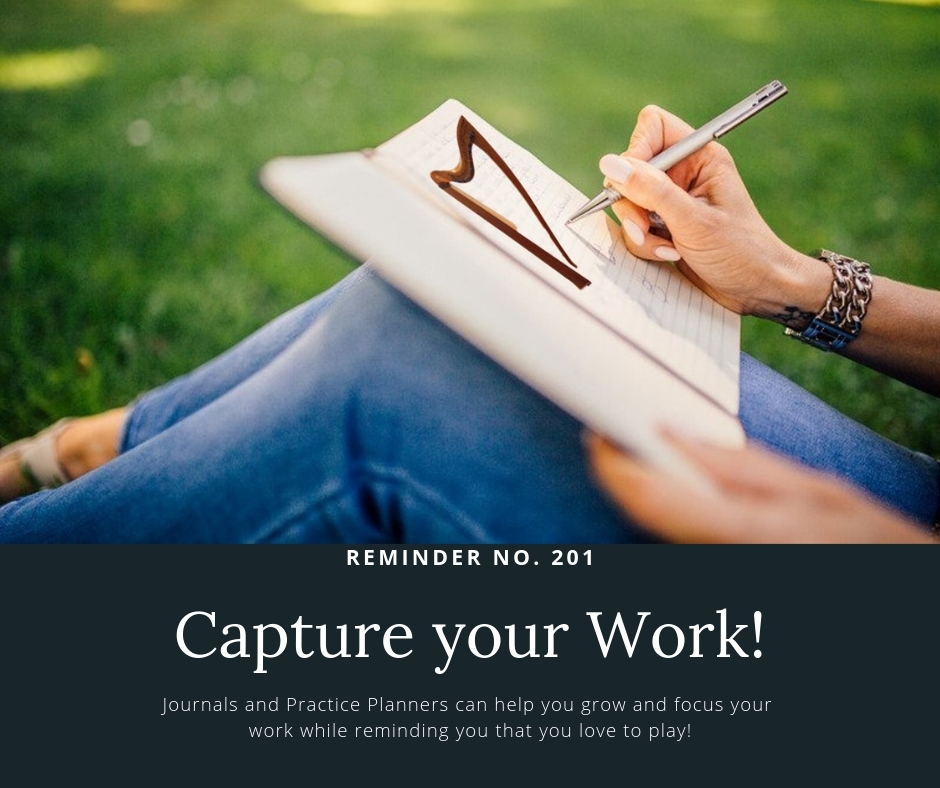 Planners and Journals serve two different functions. A Planner is forward looking, capturing what you should be working on, and how to schedule it all into your practice time (by the hour, the day, the week, the month, the season, the year, etc.). It describes what your teacher (or you, if you are actively using it) would like you to work on so that you continue to grow and so that you build the skills needed for the repertoire you will attempt in the future. It helps to organize your time spent and usually includes short term goals (which are actually criteria that, when reached, indicate readiness to move forward).
Planners and Journals serve two different functions. A Planner is forward looking, capturing what you should be working on, and how to schedule it all into your practice time (by the hour, the day, the week, the month, the season, the year, etc.). It describes what your teacher (or you, if you are actively using it) would like you to work on so that you continue to grow and so that you build the skills needed for the repertoire you will attempt in the future. It helps to organize your time spent and usually includes short term goals (which are actually criteria that, when reached, indicate readiness to move forward).A Journal, on the other hand, is, by definition, a retrospective of your work – mental, physical, emotional, and more. It can incorporate external factors (e.g. “I didn’t practice all week because I was on a cruise, but when I returned, I was delighted to be behind the harp once again and I quickly conquered my new tune that I was having trouble with before” or “I had a terrible week at work and I just didn’t feel like practicing which explains why I haven’t made progress with my tunes this week, but next week should be better!”). You write in your Journal after you practice or play, while reflecting on what happened, why, how you feel about that, and perhaps what you’d like to add to your planner (to avoid a negative or to reinforce something you see needs shoring up). And of course, you will, on occasion, go back and read through your thoughts and feelings to rediscover items that have fallen through your mental cracks.
A practice planner should be very clear and detailed – a set of instructions for the week. What (specifically) should you be focused on? At what point, then, do you move on for the next time? How many times to do the scales? In which key? What are your warm-ups this week? What skill builders will you do? What musicality exercises will you work on? How do you know when to stop? How good is good enough? What is expected of you in the practice time allotted?
A journal allows you to express your assessment of your practice time and your ideas on your progress (NB – this is NOT a platform for your inner critic! Rather you are capturing your opinion in a constructive way, so you can grow from it). You might include thoughts like “although I thought I’d never “get” those funky chord exercise note progressions, with three days of focused attention, I do “get” it and can now focus on the technique work that the exercise is needed for”. A little work, a little assessment, a little reflection, a lot of growth! You are also not limited in how you might capture those thoughts, reflections, and feelings – write, jot, paint, whatever will help you remember later on.
So, which should you have? A Planner or a Journal?
You need the Planner and the Journal! The real question is – in what form? The right answer is – in the form that works for you!
You can use simple planner sheet (want a free one? Subscribe here!) and a journal book. Then you have two things to work together to suggest your practice time. You want (and need) order and structure for the planner, so that the homework notes from your lesson help you to structure your practice time and to prepare for your next lesson. But you also need and want the freedom to capture your thoughts as they come and as they are best expressed. If you’re lazy like me, you want to have it all in one place. I prefer this for my students because it also provides a continuity to our discussion from lesson to lesson – one place for all thoughts.
Are you already journaling? Using a practice planner? What’s your method? And if you’re not, what’s stopping you? Journals and Practice Planners can help you grow and focus your work while reminding you that you love to play! No matter what form it takes, there is a lot of potential in writing it down. You can do this yourself – just get a notebook and start writing. But if you’d like a bespoke one, I can help you with that too – just leave a request in the comments and I’ll get back to you with details.
-
First Day of Spring – Get outside!
No matter where you live, the first day of Spring can be a wonderful day. The farther you are from the equator (and whether you have Spring in March or September), Spring portends change and newness. Although I grew up near enough to the equator that Spring is just another day on the calendar, I now live where Spring occurs very palpably. And although it is my least favorite season, I still very much look forward to it’s arrival.
Here we are slowly transitioning from winter, and just now we are enjoying a faux May day. Of course, we’re not quite there yet and we will be returning to our regularly scheduled March in just a few hours. But for the moment, it is Spring. And it’s a perfect day to take get harp outside…and play!
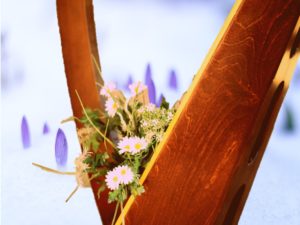 There are all kinds of reasons to take the opportunity to do it right now!
There are all kinds of reasons to take the opportunity to do it right now!- The fresh air will do you good. There’s a reason “Spring Cleaning” is a thing. We have been cooped up in furnace air for months, so a little fresh air will be a welcome change (and you also want to enjoy it before A/C season shuts you up again).
- The sunlight will do you good. This is a perfect time – bright clear days while the sun angle is changing – it’s not beating down on you or your harp. No sweating on the soundboard. No worrying that the glue might be in jeopardy. Research keeps showing the importance of getting some sun – to collect Vitamin D precursors, to stave off the winter blahs, and to put the finishing touches on your adaptation to the time change. Playing your harp will only enhance all that.
- The warmth will do you good. Some research suggests that you will feel better with just 15 minutes of contact with the earth each day. When it’s Spring, it is warm enough to take your shoes and socks off and keep your feet on the ground. No matter how it operates, taking 15 minutes to stand still (or sit still) will do you good.
- Being present will do you good. Sometimes when we take our harps outside, we are worried – will the harp be stable? will other people hear me? does anyone see me? We might feel exposed with our bare arms and our bare harp. But that’s not the point. Instead – be present. Enjoy the feel of the wood, the strings, the air, the sun, the deck/park/garden/yard in which you are sitting, the breeze, the sound. Be present and remind yourself how much you enjoy the feeling of playing – no matter how experienced you are (or aren’t).
Spring is a great time to remind yourself to be thoughtful. After the bundled up, flurry and flutter of the holidays and the start of the new year – take a breath. Be here. Now. Enjoy your harp.
Go play now. Spring is fleeting. Soon it will be Summer, with its hustle and bustle and A/C and harp events! Ok. Gotta go – the deck is calling me, the trees are beckoning, the birds are off key so they need help. Where will you play? Let me know in the comments below!
-
We’re all made of Stories – The Comparison Trap
We humans observe…and then compare. We are always collecting data about the world around us, analyzing it, and then selecting a winner. We have a classification scheme for winners and not winners – so we see where we rank in there.
This comparison trap is insidious in two ways. It assumes that you are an unbiased (and knowledgeable) arbiter of truth and it rarely takes context into account.
And typically, when we make comparisons, we find ourselves wanting.
Finding yourself wanting is not motivating.
 Are you a “Fair Witness” *? Are you certain that you are qualified to critique the performance of others relative to your own? And can you say, perhaps with more certainty, that you are qualified to evaluate your own performance – clear eyed and unbiased? Are you a Fair Witness to yourself that you can only report the truth with no trace of bias? Likely not – you have a vested interest in the outcome, so be honest about your ability to assess.
Are you a “Fair Witness” *? Are you certain that you are qualified to critique the performance of others relative to your own? And can you say, perhaps with more certainty, that you are qualified to evaluate your own performance – clear eyed and unbiased? Are you a Fair Witness to yourself that you can only report the truth with no trace of bias? Likely not – you have a vested interest in the outcome, so be honest about your ability to assess.I just learned that my sister writes poetry. I learned this while thumbing through an anthology in which she is published! This very clearly highlighted the second point of context. You very rarely have insight into the context of others (even in a close relationship). Even though we are all made of stories – we don’t tell them all to everyone. And there are some we tell no one. In addition, many have no insight into the context of themselves, much less that of others. And even if you know someone, you might not have an accurate view of their context.
On occasion, you’ll hear someone “praise” another by stating baldly that playing the harp comes easily to (another). I find this both horrifying and irritating. You might think you should be delighted to receive what might be meant as a compliment. But because you have worked quite hard to be where you are, and even if you give the illusion that it comes easily, you might rather be annoyed that someone has discounted all that hard work. When you compare your own playing to someone else’s (or someone compares themselves to you), you never know the entire context – where they are, what is happening, or how your comparison may upset them. By the same token you may not be fully aware of how things affect you and impact your own playing.
As the trope goes (did you know that “trope” originated as a music term?) Comparison is the thief of joy. Why do we make comparisons? Because we’re good at it. We are quite adept at making pairwise comparisons (choosing a preference between two options). There are entire lines of research built on these comparisons – we’re that good at making them! But in this case, our strength (comparison) is a real weakness – because, you don’t have to pick! Someone else can be good and you are still too!
In addition, comparing yourself to someone else is more likely to make you feel bad than to make you play better (and you can see how that’s not helpful – the comparison makes you feel bad, so you’re not motivated to practice, so you do not become better (and may lose ground), which makes you not play as well the next time you’re with others and your comparison results in your poorer showing – etc.…you can see how that’s a downward spiral of not very helpful).
At a recent workshop I overheard a relatively new harper wistfully comment, “I’ll never play as well as (insert significantly experienced, p-r-o-f-e-s-s-i-o-n-a-l harp player here).” ** Well, DUH! Of course you don’t! You’ve been playing the harp for 10 minutes and they’ve played for 20/30/40 years. You dabble, fit it in, get to it when you can, as a hobby. That person is a pro – it’s their job! And they are seasoned, they work at it – you know, for hours – every day. And they are absorbed in multiple aspects of being a musician, not just the practicing for 20 minutes when they can!
Of course you don’t play at the same level! When I overhear this, I am always tempted to ask, “Do you w-a-n-t to play at that level? Or do you just wish you played at that level?” Big difference! (of course, the start of the difference is – you know what I’m going to say – practice!)
Do you say to every Dentist or Auto Mechanic you meet, “oh, I wish I pulled teeth or rebuilt transmissions as well as you”? Bah! No, you don’t, so why do you do that with harpers? (and if you do, stop, you’re creeping people out!).
But how can you escape the Trap and emerge solid in your own story (and possibly helping other people grow fully into their own stories)?
Be honest – and clear – about where you are and where the other person is (and the path from here to there). And be frank about your willingness to take that same path (or not)!
Be content, but not complacent – You are where you have gotten. You are not your harp hero. But you might be someone else’s (did you ever think about that?). So kindly and gently encourage yourself to continue to work and grow. You already know that it is work to continue – but it’s fun work! And there’s no deadline, so just keep at it.
Be analytical (but only part of the time) – note how much you have grown as a harp player. No, really note – be aware. At one point you hadn’t even touched a harp – and look at you now! One of the reasons I’m always exhorting you to keep a journal of your practice is so that you record (and therefore don’t forget and can review) your small, “every day” successes! Because those small accomplishments are what matter.
Be-YOU-tiful (stolen from a tea towel!) – you are amazing! Be that. You have strengths and weaknesses – just like everyone else. Celebrate your strengths. Be mindful of your weaknesses. Work on those weaknesses you want to be stronger at, set up systems to support the ones you know need work (but are still working on), and forget the rest. If you have to, turn your picture upside down so the weaknesses are in fine print at the bottom rather than in headlines at the top of your page.
There is one comparison that does matter – how are you now relative to you previously? Are you growing? Are you becoming the you that you want to be (not wish – but want). Do your thing. Let everyone else worry about being them. Do you have another way of keeping your thief of joy in check? Share that in the comments!
* If you haven’t read this, you might enjoy it – at your local library or at online
**I have no problem making this claim since I hear this at nearly every workshop I attend. -
Let the sun shine!
It’s early March and so here in the US, whether you agree or not, it’s time to set the clocks ahead – it’s Daylight Saving Time. Yea.
It’s not really all that bad. It does lead to “longer” days, in that, while the sun is up as long as it is going to be each day, the clock pushes us to use more of it awake. So it feels like we have more daylight than we do. So then the question is – what are you going to do with all that sunlight?
Well, you could use it to play your harp more! And like anything – there are bad things but also good things about moving the clocks to take advantage of the sun.
What are the bad things?
You have to get used to it. Your body is not wired to make these jolting shifts and it might take you a little time to adjust. If you don’t want to experience a wrenching difference, you could take a few days to prepare yourself – go to bed, eat, and go for a walk 15 minutes early each day from now until Sunday – that will help ease you into it. If you can’t work this shift into your schedule, at a minimum, keep to your current schedule so that you are only adapting to one hour change (sort of like jet lag!).
Everyone’s health takes a ding. Research has shown that there are more of all kinds of accidents – car, industrial, just being dumb. But also there are more heart attacks and strokes for the first week of the time change – so take care of you! Eat carefully, sleep, and take a little exercise (use all that extra daylight to go for a walk!).
Then add your harp into the mix! Now you can look at the good things –
First, acknowledge that although the time change can be a bother, you will adjust in just a few days. So cut yourself some slack. Be nice to you – don’t do a lot of forced or concentrated practice. Instead, just play and allow the sound energy to envelop you – all that vibroacousticness might help you adapt (well – it can’t hurt!).
After the first week of adaptation – you’ll be ready to use all that glorious sunlight to be more energetic – you can apply that energy to your practicing. Practice in natural sunlight. Go outside (as I write this, it’s about 20oF so that idea might have to wait!) or open the curtains and play in the window. Just take the opportunity to enjoy the sunshine!
You can let the beautiful lengthening days be an inspiration – make music, play music, share it with others! Can you compose an improvisation of the day, the transition from night to day or from day to night? It’s in you – let it out!
You may enjoy playing more. Sunlight helps combat any kind of “blahs”, so if you layer that over the joy you get from playing – you’ll be nearly euphoric. Keep that up for the eight months of DST and you’ll be…happier? Probably!
You’ll have more time to practice. Of course you won’t. But you’ll feel like you do. When the day is unending – you can practice in the morning, in the middle of the day, and in the evening and still have loads of day remaining.
So there are good things about changing the time for the spring. Layer that on top of the gentle flow of time here on earth, longer days, warmer days, an uptick in harp events everywhere (!) and it just doesn’t seem so bad. Spend a little time preparing this week and you’ll have eight months of enjoyment (before we have to get ready to go back again in November!).
PS – I’m trying to mix it up with the graphics – let me know what you think! Leave a comment below –
-
Enjoy the Silence…
Not just the enigmatic lyrics of a Depeche Mode tune but a strongly worded suggestion.
There is so much sound in our lives. Every day. Sounds we enjoy. Sounds we would rather not hear. Combinations of sounds. So many that we don’t even hear some of them. And so many that we often cannot hear ourselves think.
And note that I say sound. You may have mentally transposed that to say noise. But “Noise” carries a value judgment against the source of the sound or against it’s characteristics (like volume, timbre, pitch, complexity, etc.). But it isn’t just noise that there is so much of – there’s just a lot of sound in our world.
As musicians, we are familiar with the concept of silence. We have symbols for many types of silence (well, lengths of silence – almost as if you buy it off the bolt*). We write silences into the music all over the place.
And yet, even as musicians, we often are slightly afraid of silence. Maybe repulsed is a better word. Even the best, strictest musicians sometimes cut the sound short, not allowing it the full time allotted in the score. The longer it is, the more eerie it becomes.
We harp players have an added element to our relationship to sound. After all – so often we have at least one string continuing to oscillate – to ring on and on and on (the beauty of bass wires…the bane of bass wires). Actually getting to silence can be difficult for us. Sometimes silence becomes an anathema to us – because we are no longer used to hearing it.
Silence, the absence of sound, often makes us uncomfortable. Especially if we are performing – silence leaves us feeling naked. Almost as if we think the gossamer of sound provides a veil to protect us – without it, we are bared by the lack of vibration being put into the air.
Despite this, we know intuitively the power of silence. When you’re looking for an address or you’re lost – you turn down the radio. When you really (really really) need to study, you go somewhere quiet (even those who insist they need the sounds of the tv to study). When you need to reflect, you find a quiet spot like a shrine or a meadow or a closet. But there are other reasons to find (and enjoy) silence. Silence really can be good for you – for many reasons.
- Silence is golden (you can take that to the bank!) – you can download John Cage’s 4’ 33” from iTunes for just 99¢. Better yet, review John Cage’s earlier work and you’ll see how he might have grown into writing this piece (perhaps his most famous, and possibly his best)
- Silence does give you time to think – when it is quiet, you can think. This is especially true when you’re performing – when you not only give yourself time to think – you give your audience time to think too!
- Silence let’s you hear (especially small or infrequent sounds) – yes, I meant that – silence let’s you hear things you don’t hear otherwise. I live near two of my favorite sounds – a train and an airport – and yet, I only ever hear the trains or the airplanes in the small hours…even though I think I am always listening for them.
- Silence can be soothing – there is medical research that indicates that silence is conducive to soothing and reducing stress. If you are playing in a clinical setting, knowing this is essential…but it is also helpful if you’re playing for an audience! And don’t forget that even stress reduction can be stressful, so a little silence will be helpful.
- Silence sharpens your attention – without the distraction of sounds, you can focus on whatever you elect to attend. Whether this is your own thoughts, a project, or anything else requiring attention, you will have the capacity to focus that attention in the presence of silence.
- Silence gives you time to breathe – This might be a subset of the previous point, but silence allows you to breathe – deeply, slowly. And breathing makes just about everything else easier!
- Silence let’s you take a beat (sometimes literally!) – this might be the summation of all the points – when you can take a step back, take a beat, you gain a perspective you won’t otherwise. Be quiet, be still, breathe, think, focus….and then reengage and move forward.
Silence is like Brylcreem – a dab’ll do ya. Try injecting a little silence into your day and see what comes up. You can include some silences into your practice – by thinking before launching into whatever needs work or by pausing to think about what you’ve done and what you might do next. You could incorporate silence into your performances – don’t leap into a new tune as if you’re trying to get away from the last one – enjoy the brief silence (before the wild applause breaks out!). And you can include some silences into the rest of your day – at the beginning (before anyone knows you’re awake?) or at the end (when everyone thinks you’re asleep?) – you’ll be amazed what you find when you Enjoy the Silence!
*admit it, did you just visualize what a bolt of silence would look like?
-
Baby, It’s Dry Outside! 8 ways to take care of your skin so your hands can keep playing
No matter where you live, no matter how arctic or temperate, winter tends to be drier than the other seasons. And it’s easy to tell that when you look at your hands. In case it had escaped you, you use those hands a lot when playing the harp. So, keeping them in good shape is a good idea!
Problem is, you use your hands for so many things, it’s easy to look at them and not see them. Who really checks them every day for wear and tear? I get it – we’re busy. We wash our hands, we see them. We decorate them with rings and bracelets. But how often do you really look at them? Your hands are like that – or more specifically, the skin on your hands is like that.
It’s easy to take your skin for granted. So, it’s time to add caring for the skin on your hands to your things to do list!
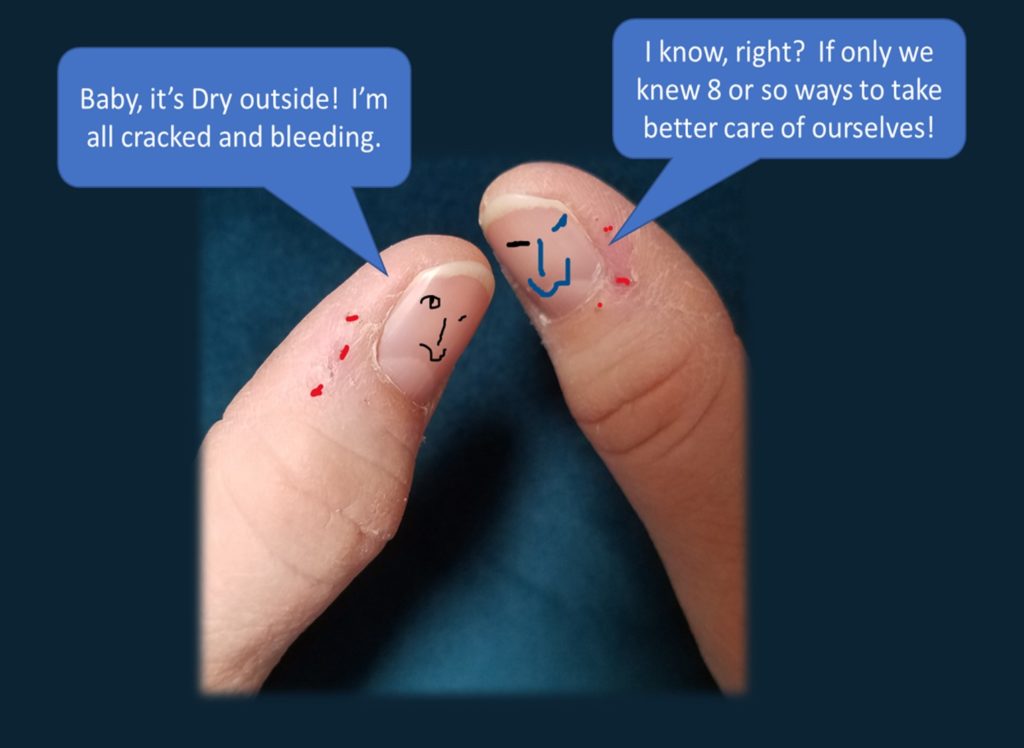 It’s winter, so the air is dry. And it’s cold and flu season, so you’re washing your hands a lot. Frequent hand washing strips the natural oils from your skin, leaving it dry and flaky. Of course, this dryness also gets more likely as your get older. If you let it go long enough, it is possible that your skin will become so dry and tight that it impacts your playing – yikes!
It’s winter, so the air is dry. And it’s cold and flu season, so you’re washing your hands a lot. Frequent hand washing strips the natural oils from your skin, leaving it dry and flaky. Of course, this dryness also gets more likely as your get older. If you let it go long enough, it is possible that your skin will become so dry and tight that it impacts your playing – yikes!What happens? Well, you already know your skin can become dry from the dry indoor (and outdoor) air, but healthy habits can also impact your hands badly. The water and soap from hand washing – both of which draw the oils away – lead to drying. And the drying after the hand washing can be a problem. Air driers blow warm, dry air at your hands and towels (including paper towels) can also “rough up” your hands (leading to chapping). Left untended, after all these assaults (albeit healthy assaults), your skin may become dry enough to feel tight, flaky, rough and it might even split or crack.
Splitting and cracking is bad for a number of reasons – it hurts and leaves your fingers sore. Sometimes you’ll also get bleeding – and no one wants that. Perhaps the worst part is that your skin is part of your immune system and these cracks and splits leave your open to infection.
So, what can you do? You can’t really take the entire winter off (ok, you could but that wouldn’t be fun!). Here are 8 ideas you can pick and choose from to improve the state of your skin throughout the winter. Many of these are basic maintenance and some are downright pampering. But caring for your hands will be good for your health and for your harping!*
- Hydrate! This is a good place to start. Because the air is so dry in the winter, you need to drink more water – or at least drink enough water. You can use your favorite rule of thumb (8 glasses, half your body weight, or “drink when you’re thirsty”!).
- Moisturize. You might think this goes without saying, but say it anyway! Use your favorite moisturizer – but use it! And remember that the skin on your hands is different in different places on your hands. Lay it on thick on the backs of your hands, get your fingertips, but maybe the palms don’t need as much of a slather? Put it where you need it. And use the product that works best for you – there are loads to choose from.
- White Glove Treatment. If you are having trouble keeping your hands moisturized, this works overnight! Wash your hands, leave them damp, slather on “too much” moisturizer (this is a good time to use an emollient rather than regular moisturizer), slip on plain cotton gloves and go to bed! Plain white cotton gloves are available on line and are inexpensive. This keeps your hands warm and traps body heat which seems to help the moisturizer “get in”. Caveats – you’ll feel ridiculous (especially if you have a roomie) and you will feel much warmer than you would otherwise while in bed (so layer your blankets accordingly).
- The Black Glove Treatment. Keep gloves in the pockets of all your coats – and wear them! I buy the cheapy Walmart ones that come in packs of three and look like they won’t fit a toddler but magically grow to be the right size when you put them on. They have all the qualities you need – they are inexpensive enough to have a lot of them so if you lose them, it doesn’t matter much (they’re like $1.25 a pair), they come in colors so they go with everything, and if it’s really really cold, you can wear two pairs). I have gloves in all my coat pockets, in the pocket of my harp case, in my gig bag, in my car, in my purse, and anywhere else I happen to stash them. Like the white glove treatment, they keep your hands warm which seems to help the moisturizer be more effective and just protects your skin in general.
- Take care of your nails. Not only do you need to keep your nails trimmed and filed to play, but you can also apply oil to the nail beds to keep your cuticles supple. There are fancy nail oils but Vitamin E oil or plain ol’ olive oil also works (you could combine this with the White Glove Treatment – and not get oil all over the place!).
- Keep your hands clean, but…. You do, of course, need to wash your hands frequently. But warm water will do – it doesn’t need to be so hot you can barely stand it! If you can, use liquid soaps. And when drying – just get to damp rather than completely dry. Then apply moisturizer. If possible, try to avoid hand sanitizer (which is typically made with alcohol – don’t believe me? Use it when your hands are chapped, and you’ll find all the little cracks you didn’t know where on your hands – ouch! Ask me how I know!). If you’re working in hospitals and health care environments, they often use a hand sanitizer that is not alcohol based. Of course, patient health is a priority, but still, you need to take care of you.
- Get a manicure! This is a little luxury! And while a good manicurist will leave you feeling heavenly (!), you can also do this at home for yourself. Just be sure you do all the steps on all of your hand! Don’t leave out the massage. One big advantage of having a professional manicure is adding the paraffin dip which is really lovely and softening!
- Deal with it. If you have cracks or splits – deal with them quickly to heal faster and to avoid infection. Use an antibacterial treatment (often typically carried in an emollient – so a two-fer!) and cover with a bandage (to protect it and to keep the antibacterial in place). If you have a gig and must play, many swear by the liquid bandage products or superglue. These hold the crack closed and will certainly make it easier to play – just be sure to try this out b-e-f-o-r-e you try to play any kind of gig, so you’ll know what works for you (but it is definitely easier than a bandage when you play the strings!).
It’s never too late to treat your hands well. Even if you’re a cracked, bleeding, sore mess – your hands will respond to a little TLC very quickly. Don’t wait! Do it today. Don’t have visibly dry hands? Build the habit now – before you need to. These small steps will certainly keep you playing comfortably throughout the cold dry months. What is in your daily routine? Do you have other great solutions you can share with the rest of us? Leave it in the comments below!
*As always, these are suggestions from my experience. I am not a health care professional nor am I a manicurist or other professional who professionally knows this stuff. If you have a health concern, see your qualified medical practitioner. And if
you know something that works well – let me know – I’m always looking for good solutions!
